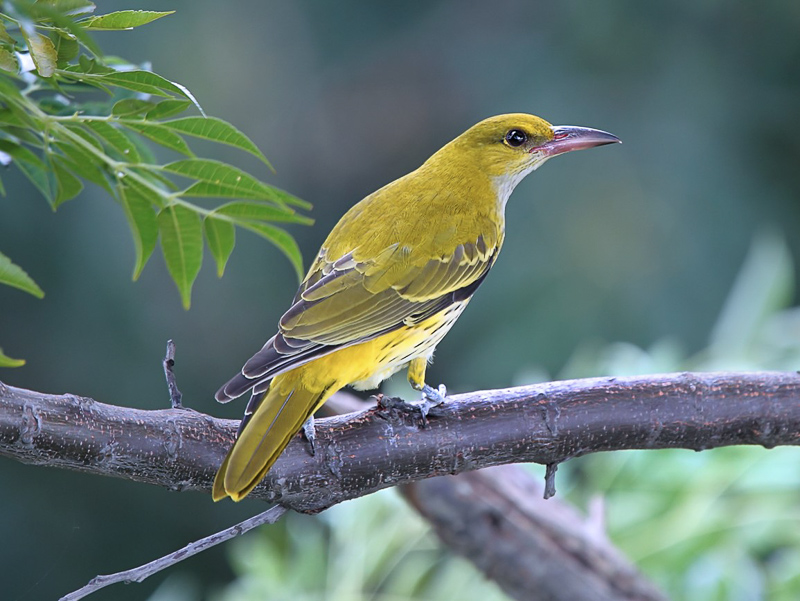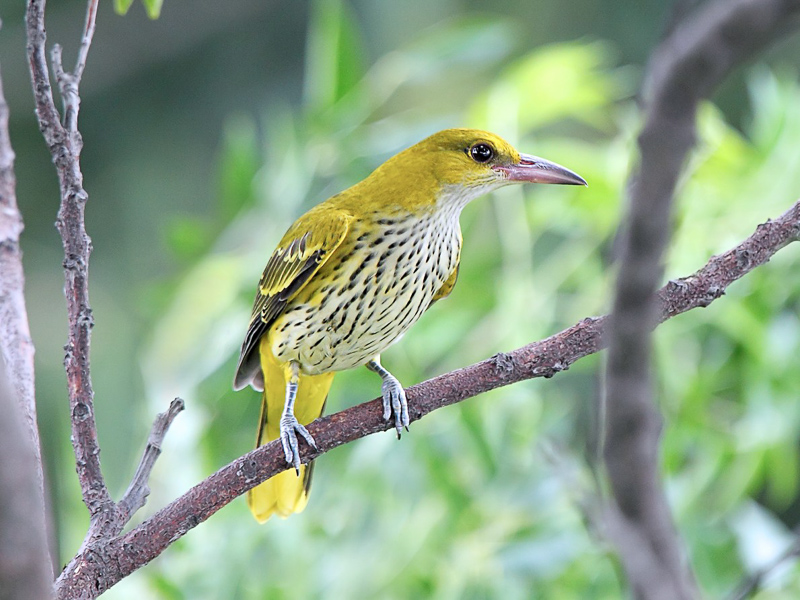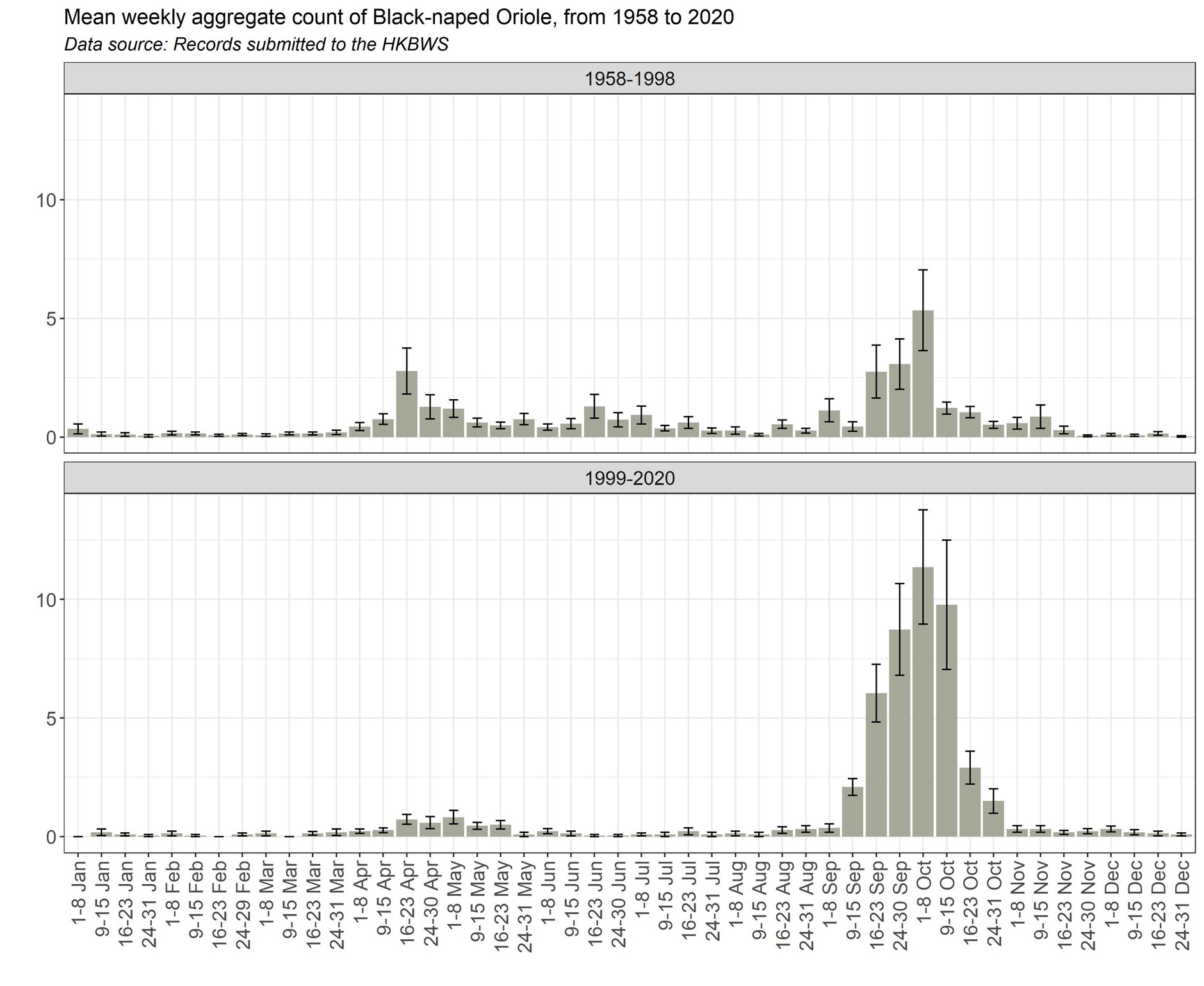Black-naped Oriole Oriolus chinensis 黑枕黃鸝
Category I. Formerly a widespread and fairly common breeding species with occasional winter records. Last proven to breed in 2003 and now a scarce passage migrant and rare winter visitor.
IDENTIFICATION

May 2014, Michelle and Peter Wong. Adult male.
23 – 28 cm. Unlikely to be confused with any other species, Black-naped Oriole is the only large black and yellow bird to be found in HK. Adult males are bright golden-yellow with largely black wings and central tail feathers, a black mask extending from the lores through the eye to the nape and a bright pink bill (shared by adult females). Adult females are somewhat variable, with some being almost as bright as males, with just a slight greenish wash on the wings and mantle, whilst others, perhaps first-summer individuals, are largely dull greenish-yellow above with blackish wings, white, heavily dark-streaked breast, whitish belly and yellow vent and a greenish-yellow head, with a rather diffuse blackish mask around the eye not reaching the nape.

Oct. 2011, Michelle and Peter Wong. Juvenile.
Some juveniles and first winter birds in autumn resemble dull or first-summer females, whilst others are a rather uniform greenish-yellow with only limited streaking on the underparts.

Oct. 2011, Michelle and Peter Wong. Juvenile.
The bill in first winter birds it is largely grey with pale pink restricted to the base of the lower mandible and along the cutting edges.
VOCALISATIONS
The song is a rich fluty phrase that varies in structure. The call most often heard is a cat-like squawk.
Recordings of this species are not freely available on Xeno-canto.
DISTRIBUTION & HABITAT PREFERENCE
Currently Black-naped Oriole is largely a scarce passage migrant to HK. However, this is a species the status of which has changed greatly over the years. The first reference to its occurrence is provided by Hutson (1930) who suggested that numbers of Black-naped Orioles in HK were increasing. Whilst it is impossible to be certain, it seems likely that Black-naped Oriole was an early 20th century colonist as a breeding bird, at least on HK Island, as it was not listed from HK by Swinhoe (1861), Kershaw (1904) or by Vaughan and Jones (1913) who made a specific reference to not having seen it there. As was suggested by Carey et al. (2001), it may be that the failure of earlier authors to record it (in particular Swinhoe (1861), who, as they noted, was present on HK Island during spring and visited localities that were subsequently strongholds of the species in the late 1930s) was because it was absent due to the lack of large trees required by this species as breeding habitat.
After Hutson (1930), Herklots (1936) described it as a summer visitor occurring regularly at several locations on HK Island and in the Sha Tin, Tai Po and Tsuen Wan areas of the New Territories, with occasional winter records. Herklots also considered that it seemed to be increasing in numbers but noted that greater knowledge of its habitat requirements and habits might partially explain this apparent increase. To this could be added that it seems it was not until the 1930s that much of the New Territories received regular visits from birdwatchers. In the 1950s, Dove and Goodhart (1955) recorded Black-naped Orioles in summer at Pok Fu Lam, the Zoological and Botanical Gardens, Tai Po and the Fanling Golf Course area where they noted several pairs in summer.
However, as was documented in detail by Carey et al. (2001), the breeding range began to decline in the 1960s; it disappeared from HK Island by around 1970, and its apparent strongholds in the Fanling, Tai Po and Shek Kong areas by the early 1980s, though there were scattered breeding records, from the central and northern New Territories in the 1990s.
After the period documented by Carey et al. (2001), there were summer records from Fanling Golf Course and Lok Ma Chau in 1999, whilst in the period from 2000 to 2010 there were summer records from scattered sites in the northern New Territories, especially Lok Ma Chau, San Tin and Ma Tso Lung, with successful breeding confirmed at Lok Ma Chau in 2003. Away from the northern New Territories, there were summer reports of one or two singing males from the same site on Cheung Chau in 2001 and annually from 2007 to 2010, and breeding was considered likely to have taken place. Since 2010, however, there have been no reports outside the spring and autumn passage periods. The only evidence that breeding may still occasionally occur is of a singing male on 6th and 8th May 2019 on Cheung Chau and a singing male and a female in suitable breeding habitat at Shek Wu Wai on 24th and 25th May 2020, with the male present to 7th June.
As a breeding species Black-naped Oriole appeared largely to be associated with large trees in gardens or parkland at such sites as the Zoological and Botanical Gardens and Fanling Golf Course; albeit most of the summer records since the first Avifauna came from the fringes of fish pond areas. Passage migrants are typically found in well-known migrant ‘hot spots’ such as Po Toi and Ho Man Tin, as well as the Inner Deep Bay area.
Carey et al. (2001) considered the reasons for the disappearance of the Black-naped Oriole as a breeding species in HK to be uncertain. They suggested that urbanisation might be one factor, whilst another was the decline in Chinese Red Pine Pinus massoniana, considered to be important foraging habitat by Herklots (1967), caused by the introduced Pinewood Nematode Bursaphelenchus xylophilus. They also considered the apparent association between Black-naped Orioles and Hair-crested Drongos during the breeding season and the presumed protection of nests that the orioles derived from the aggressive drongos, as suggested by Herklots (1967), was less likely to be a factor as though both species had disappeared from some areas such as HK Island, the drongo remained widespread in the New Territories.
Whilst, the reasons for the decline remain uncertain, a further related possibility, which might at least partially explain the decline, is perhaps worthy of consideration: the parkland habitat favoured by this species for breeding purposes is a rather rare habitat in HK, and much of it is managed intensively using horticultural and pest control practices, such as the application of herbicides and insecticide fogging that are likely to adversely affect numbers of caterpillar and other invertebrate prey on which Black-naped Orioles and other insectivorous birds depend.
OCCURRENCE
In spring, Black-naped Oriole now occurs between late March and early June with the main period of occurrence being the third week of April to the third week of May. In autumn, when larger numbers are seen, it passes through from late August to early December, with peak numbers recorded from late September to mid-October. Passage birds are usually recorded as singles or several individuals, the largest party recorded being a loose flock of 30 birds at Tsim Bei Tsui on 21 September 1986; 20 migrating at Lung Kwu Tan on 2 October 2020 is the highest count since that date.
Compared with the 1979-98 period analysed in the first Avifauna, a higher proportion of records now occur in autumn and, set against increased observer activity, fewer absolute numbers of birds are recorded in spring. In addition, the peak of spring migration shown by Carey et al. (2001) in both 1958-78 and 1979-98 was 9th to 23rd April, whereas since 1999 there has been no clear peak. However, the timing of autumn migration appears to be unchanged, though the increase in observer activity makes it difficult to say anything about the numbers recorded.
Formerly Black-naped Oriole was very rare in winter, but since around 2012 two or three individuals have been seen in most winters, the latter change being a pattern shared with several other species primarily occurring in HK as passage migrants and no doubt being a consequence of warmer winters in recent years.
BREEDING
Historically, breeding birds arrived from about 8th or 10th April and immediately commenced breeding activities with nests typically laid around the third week of May but occasionally earlier. Nests were placed high in a tree, typically 12-15m, and usually towards the tip of a thin branch (Vaughan and Jones 1913). In HK Herklots (1967) stated that nests were usually placed in Chinese Red Pines Pinus massoniana, but the nest at Lok Ma Chau in 2003 was placed in a Chinese Banyan Ficus microcarpa overhanging a watercourse; Vaughan and Jones also noted nesting in both banyans and Cotton Trees Bombax ceiba. As noted above, Herklots (1967) considered that Black-naped Orioles frequently placed their nests close to the nest of, and sometimes in the same tree as, a pair of Hair-crested Drongos, the orioles receiving protection from the vigorous territorial defence undertaken by the drongos.
The nest is a deep cup slung within the fork of a branch and is made up of a variety of plant materials including leaves, grass, banyan roots and cobwebs. Two to four pale pink eggs covered with small dark chocolate spots and fewer lavender spots are laid (Herklots 1967). Vaughan and Jones (1913) considered Black-naped Oriole to be single brooded with most birds departing from breeding sites in the third week of August, but also noted that eggs had been found as late as 5th July.
BEHAVIOUR, FORAGING & DIET
In HK Black-naped Orioles are usually seen perched in or flying between larger trees. Birds readily fly over open habitats such as fields or fish ponds and owing to their relatively large size and bright colouration many observations are of distant flying birds.
Black-naped Orioles appear to obtain most of their food by gleaning in the canopy of larger trees. This accords with the observation by Herklots (1967), who considered that Black-naped Orioles in the Pok Fu Lam area spent much of their time foraging in Chinese Red Pine and that much of their diet consisted of caterpillars. Presumably it is an insectivore-frugivore, but there do not appear to be any observations of frugivory in HK.
RANGE & SYSTEMATICS
Black-naped Oriole has an extensive range throughout south and east Asia, extending from India in the west to Ussuriland in the northeast and the Lesser Sunda Islands (East Nusa Tenggara) in the southeast.
O. c. diffusus is found in most of China, including HK, whilst one other taxon, O. c. tenuirostris, occurs in southern Yunnan. O. c. diffusus breeds as far north as Ussuriland and Korea and in most of central and eastern China north to Beijing and west to Gansu, central Sichuan and eastern Yunnan, where it is stated to intergrade with O. c. tenuirostris (Cheng 1987), and south to northern Vietnam and Myanmar. Most of this range is vacated in winter (populations in Taiwan and perhaps Hainan are resident), with the winter range extending from southeast India to Indonesia where it overlaps with other resident taxa currently included in this species.
As currently constituted, Black-naped Oriole has 20 subspecies; however, the current ‘species’ is both paraphyletic with respect to Eurasian Golden Oriole O. oriolus and Indian Golden Oriole O. kundoo and includes a number of resident taxa in the Indonesian archipelago that are probably worthy of species status (Eaton et al. 2021).
CONSERVATION STATUS
IUCN: Least Concern. Population trend decreasing.
Figure 1.

Cheng, T. H. (1987). A Synopsis of the Avifauna of China. Science Press, Beijing.
Dove, R. S. and H. J. Goodhart (1955). Field observations from the Colony of Hong Kong. Ibis 97: 311-340.
Eaton, J. A., B. van Balen, N. W. Brickle and F. E. Rheindt (2021). Birds of the Indonesian Archipelago, Greater Sundas and Wallacea. Lynx Edicions, Barcelona.
Herklots, G.A.C. 1936. The birds of Hong Kong. Part XXIII. Family Oriolidae. Hong Kong Naturalist 7: 99-101.
Hutson, H.P.W. 1930. The birds of Hong Kong. Hong Kong Naturalist 1: 2 – 7.
Herklots, G. A. C. (1967). Hong Kong Birds (2nd ed.). South China Morning Post, Hong Kong.
Kershaw, J. C. (1904). List of birds of the Quangtung Coast, China. Ibis 1904: 235-248.
Swinhoe, R. (1861). Notes on the ornithology of Hong Kong, Macao and Canton, made during the latter end of February, March, April and the beginning of May 1860. Ibis 1861: 23-57.
Vaughan, R. E. and K. H. Jones (1913). The birds of Hong Kong, Macao and the West River or Si Kiang in South-East China, with special reference to their nidification and seasonal movements. Ibis 1913: 17-76, 163-201, 351-384.

